Discover nature
Grow beans in a jar – it’s easy!
From planting to harvest: learn about the different growth stages of plants and harvest your own beans.

![]()
header.search.error
Discover nature
From planting to harvest: learn about the different growth stages of plants and harvest your own beans.

What you’ll need
How to do it
Topsy’s tip
Learn with Topsy
When you plant vegetables, you need to know the right time and conditions for good growth. The time of year and temperature must be right and so too must the nutrients in the soil and moisture levels. Light levels must also be correct.
Were you able to observe each stage of your bean’s growth? It’s a fascinating journey at every stage. In simple terms, plant growth can be understood as follows: